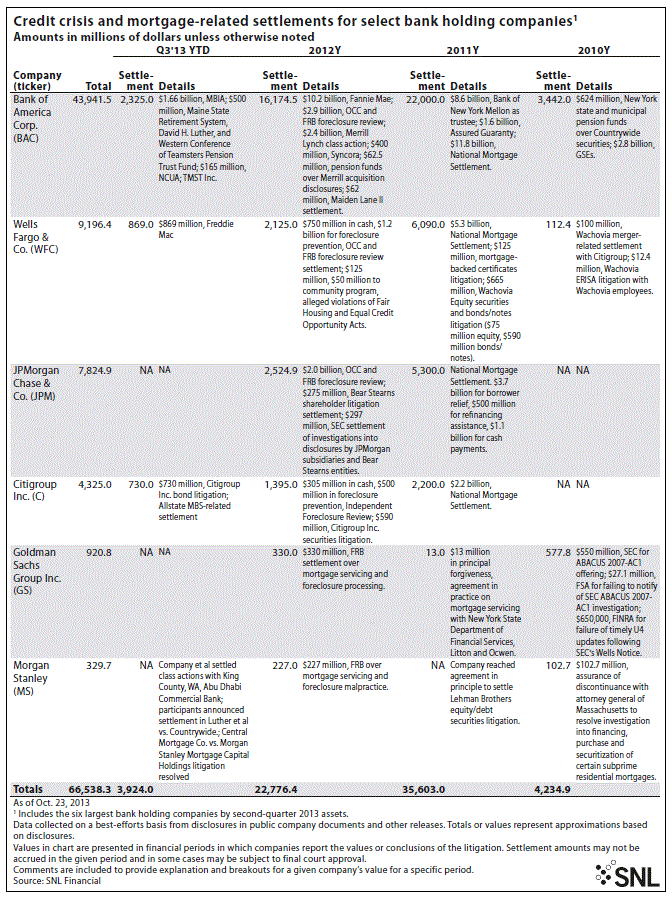On Wednesday, JPMorgan Chase (NYSE: JPM ) shares were trading a penny shy of $50. Today, the superbank has broken through the $50 barrier, and is trading at $50.21 two hours into the day: up 1.09% since the opening bell after being up 0.13% in overnight trading.
Given the trials and travails the bank has been experiencing lately, and truthfully, ever since the London Whale trading scandal broke last year, this is a bit of a shocker -- one that defies easy explanation.
Market roundup
And before we even attempt one, here's what JPMorgan's peers and the markets are up to so far:
Bank of America is already up a big 2.16%. Citigroup is also up big: 1.91%. Wells Fargo (NYSE: WFC ) -- the low-drama, Steady Eddie of big banking -- is up a more measured 1.15%.
The markets are all in the green so far, as well:
The broader S&P 500 is up 0.80%. The narrower Dow Jones Industrial Average is up 0.50%. The Nasdaq Composite is up 0.77%.
Foolish bottom line
Without a doubt, the primary explanation for today's share-price jump is the simple fact that the markets are all up. A rising tide is lifting all boats. But JPMorgan had a big day yesterday, too, while its peers didn't, and today's bull market can't explain that.
10 Best Penny Stocks To Buy For 2014: PostRock Energy Corporation(PSTR)
PostRock Energy Corporation, an integrated independent energy company, engages in the acquisition, exploration, development, production, and transportation of oil and natural gas in the United States. It operates in two segments, Oil and Gas Production, and Natural Gas Pipelines. The Oil and Gas Production segment primarily focuses on the development of coal bed methane in the Cherokee basin and the Marcellus Shale in Appalachian Basin, as well as has oil properties in Central Oklahoma. As of December 31, 2009, it had approximately 51.9 billion cubic feet equivalent (Bcfe) of estimated net proved reserves; development rights to approximately 516,184 net acres; and operated approximately 2,849 gross wells in the Cherokee Basin. It also had approximately 44,507 net acres of oil and natural gas producing properties with estimated proved reserves of 18.9 Bcfe and approximately 498 gross wells in Appalachian Basin; and had 65 gross wells, development rights to approximately 1,4 80 net acres, and estimated net proved reserves, 3.9 Bcfe in Central Oklahoma. The Natural Gas Pipelines segment involves in transporting, gathering, treating, and processing natural gas. It owns and operates a natural gas gathering pipeline networks of approximately 2,173 miles in the Cherokee Basin and 183 miles in the Appalachian Basin; and a 1,120 mile interstate natural gas pipeline, which transports natural gas from northern Oklahoma and western Kansas to the metropolitan Wichita and Kansas City markets. The company is headquartered in Oklahoma City, Oklahoma.
Advisors' Opinion: - [By Eric Volkman]
LeBlanc is a veteran energy industry CFO. He has filled that role at East Resources -- now a unit of Royal Dutch Shell (NYSE: RDS-A ) -- as well as�PostRock Energy (NASDAQ: PSTR ) , and Range Resources, among others.
10 Best Penny Stocks To Buy For 2014: Homeowners Choice Inc.(HCII)
Homeowners Choice, Inc., an insurance holding company, provides property and casualty insurance in Florida. The company provides property and casualty homeowners? insurance, condominium owners? insurance, and tenants? insurance to individuals owning property. It serves approximately 59,500 policyholders primarily through independent agents. The company was founded in 2006 and is headquartered in Tampa, Florida.
Advisors' Opinion: - [By CRWE]
Homeowners Choice, Inc. (Nasdaq:HCII), a Florida-based insurance holding company, reported that its board of directors has declared cash dividends of 5.833 cents per share on its Series A Cumulative Redeemable Preferred Stock (“HCIIP”) for the months ending September 30, October 31 and November 30, 2012.
PIMCO California Municipal Income Fund III is a close ended fixed income mutual fund launched and managed by Allianz Global Investors Fund Management LLC. It is co-managed by Pacific Investment Management Company LLC. The fund invests in fixed income markets. Its investment portfolio include California municipal bonds, and other municipal bonds and notes; California variable rate notes and other variable rate notes; California variable rate demand notes and other variable rate demand notes; U.S. treasury bills; and call options written and put options written. Allianz Global Investors Fund Management LLC serves as an investment Manager to the fund. PIMCO California Municipal Income Fund III was formed in 2002 and is based in New York City.
10 Best Penny Stocks To Buy For 2014: Sutron Corporation(STRN)
Sutron Corporation designs, manufactures, and markets products and solutions for the collection and monitoring of hydrological, meteorological, and oceanic data for the management of critical water resources and optimization of hydropower plants, as well as for warning of disastrous floods, storms, or tsunamis. The company?s Hydromet Products division manufactures real-time data collection and control products consisting of dataloggers, satellite transmitters/loggers, water level and meteorological sensors, and tides monitoring systems. Its Integrated Systems division provides system integration services consisting of the design, integration, installation, and commissioning of customer-specific hydrological and meteorological monitoring and control systems. These systems also include software applications based on it XConnect database software and Ilex Tempest database software. This division also integrates and installs airport weather systems. The company?s Hydrological Services division provides hydrologic services, including data interpretation and analysis, flow modeling, field studies, hydrologic studies, environmental permitting, legal or expert witness and equipment integration, installation, commissioning, and maintenance services. Its Ilex division offers Tempest database software, DOMSAT systems, custom software, and engineering services. The company primarily serves federal, state, local, and foreign governments; engineering companies; universities; and hydropower companies. Sutron Corporation markets its products through direct sales force in the United States, as well as through resellers and agents in Canada, Latin and South America, Europe, Africa, Asia, and Australia. The company was founded in 1975 and is headquartered in Sterling, Virginia.
10 Best Penny Stocks To Buy For 2014: Enstar Group Limited (ESGR)
Enstar Group Limited, through its subsidiaries, acquires and manages insurance and reinsurance companies in run-off. The company settles insurance and reinsurance claims. It also offers management and consultancy, claims inspection, and reinsurance collection services to its affiliates and third-party clients. The company operates in the United States, Bermuda, the United Kingdom, Europe, and Australia. Enstar Group Limited was formerly known as Castlewood Holdings Limited and changed its name to Enstar Group Limited. Enstar Group Limited was founded in 2001 and is based in Hamilton, Bermuda.
10 Best Penny Stocks To Buy For 2014: Natural Alternatives International Inc.(NAII)
Natural Alternatives International, Inc. provides private label contract manufacturing services to companies that market and distribute vitamins, minerals, herbs, and other nutritional supplements, as well as other health care products, to consumers in the United States and internationally. It offers strategic partnering services, including customized product formulation, clinical studies, manufacturing, marketing support, international regulatory and label law compliance, international product registration, packaging in multiple formats, and labeling design. The company also develops, manufactures, and markets its own branded products under the Pathway to Healing product line through print media and the Internet distribution channels. It manufactures products in various forms, including capsules, tablets, chewable wafers, and powders. The company was founded in 1980 and is headquartered in San Marcos, California.
10 Best Penny Stocks To Buy For 2014: Taiwan Greater China Fund(TFC)
Shelton Greater China Fund is a close ended equity mutual fund launched and managed by CCM Partners, LP. The fund is co-managed by Nikko Asset Management Co. Ltd. It primarily invests in public equity markets of Taiwan. The fund seeks to invest across diversified sectors. It benchmarks the performance of its portfolio against the Taiwan China Strategy Index, TAIEX, and MSCI Taiwan Index. The fund was formerly known as Taiwan Greater China Fund. Shelton Greater China Fund was formed in July 1988 and is domiciled in the United States.
10 Best Penny Stocks To Buy For 2014: Cowen Group Inc.(COWN)
Cowen Group, Inc. is a publicly owned asset management holding company. Through its subsidiaries, the firm provides alternative investment management, investment banking, research, and sales and trading services for its clients. It manages separate client focused portfolio through its subsidiaries. Through its subsidiaries, the firm invests in equity and fixed income markets. It also invests in alternative investments markets through its subsidiaries. Cowen Group, Inc. was founded in 1994 and is based in New York, New York with additional offices in Boston, Massachusetts, Chicago, Illinois, Cleveland, Ohio, Dallas, Texas, and San Francisco, California.
10 Best Penny Stocks To Buy For 2014: Life Partners Holdings Inc(LPHI)
Life Partners Holdings, Inc., through its subsidiary, Life Partners, Inc., operates in the secondary market for life insurance in the United States. It facilitates life settlement transactions by identifying, examining, and purchasing the policies as agent for the purchasers. The company?s financial transactions involve the purchase of life insurance policies at a discount to their face value for investment purposes. It serves institutional purchasers, which include investment funds designed to acquire and hold life settlements; and retail purchasers, such as high net worth individuals. The company was founded in 1971 and is based in Waco, Texas.
10 Best Penny Stocks To Buy For 2014: Trailer Bridge Inc.(TRBR)
Trailer Bridge, Inc., an integrated trucking and marine freight carrier, provides freight transportation services between the continental United States, Puerto Rico, and the Dominican Republic. It provides services through southbound containers and trailers, as well as through marine vessels that are configured to carry 48 inch and 53 inch long, and 102 inch wide high-cube equipment. The company also involves in moving new and used automobiles, non-containerized or freight not in trailers, and freight moving in shipper owned or leased equipment. It offers highway transportation services in the continental United States; and marine transportation services between Jacksonville, Florida, San Juan, Puerto Rico and Puerto Plata, and the Dominican Republic. The company also provides rail transportation services. In addition, it engages in chartering its vessels that are not in liner service to third party operators. The company ships furniture, consumer goods, raw materials for manufacturing, electronics, new and used automobiles, and apparel to Puerto Rico; healthcare products, pharmaceuticals, electronics, shoes and recyclables from Puerto Rico; raw materials for manufacturing to the Dominican Republic; and apparel, raw materials for manufacturing, and recyclables from the Dominican Republic. As of December 31, 2010, it operated a fleet of 141 tractors comprising of 79 company owned units and 62 leased and owner operator units; 2 736' triple-deck ro/ro ocean-going barges and 5 triplestack box carriers; and 3,957 high cube containers, 3,157 chassis, 164 high-cube trailers, and 299 vehicle transport modules, as well as leased 435 chassis and 531 high-cube containers. Trailer Bridge, Inc. was founded in 1991 and is headquartered in Jacksonville, Florida.
 Source: snl.com
Source: snl.com





 For starters, on the weekly chart of this stock we can see how it's rocked its way out of a long-term wedge pattern, and above the upper edge of that triangle shape.
For starters, on the weekly chart of this stock we can see how it's rocked its way out of a long-term wedge pattern, and above the upper edge of that triangle shape.


 Hosted by Marketfy
Hosted by Marketfy  Get Benzinga's News Delivered Free
Get Benzinga's News Delivered Free


 Popular Posts: 5 Fire-Breathing China Mutual Funds to BuyThe Gun Stocks Trade Is Still FiringForget Amazon and eBay — China Has the Hottest Online Retailers Recent Posts: The Gun Stocks Trade Is Still Firing SSO — Double Down When D.C.’s Squabbles Die Down 5 Fire-Breathing China Mutual Funds to Buy View All Posts
Popular Posts: 5 Fire-Breathing China Mutual Funds to BuyThe Gun Stocks Trade Is Still FiringForget Amazon and eBay — China Has the Hottest Online Retailers Recent Posts: The Gun Stocks Trade Is Still Firing SSO — Double Down When D.C.’s Squabbles Die Down 5 Fire-Breathing China Mutual Funds to Buy View All Posts